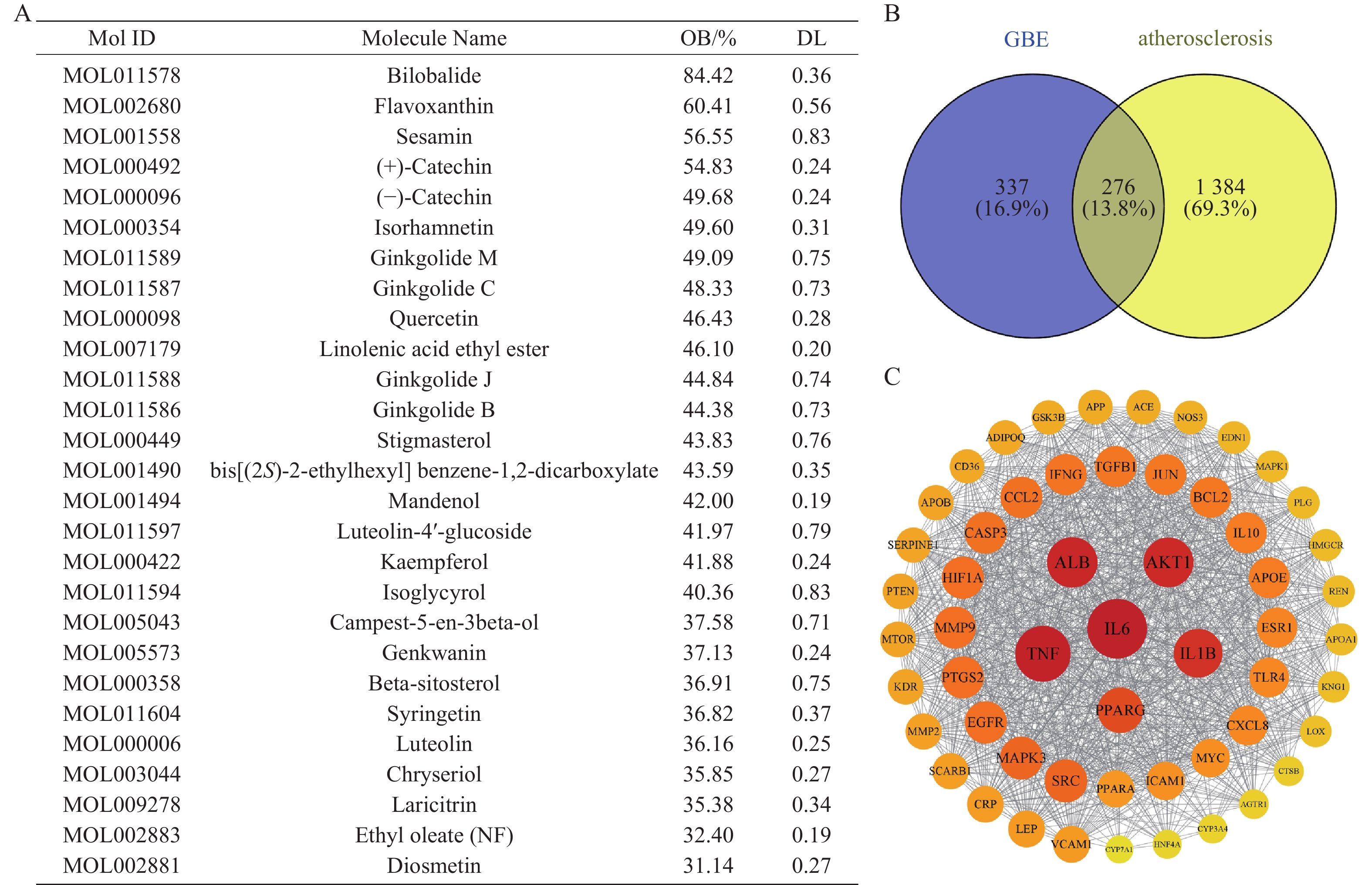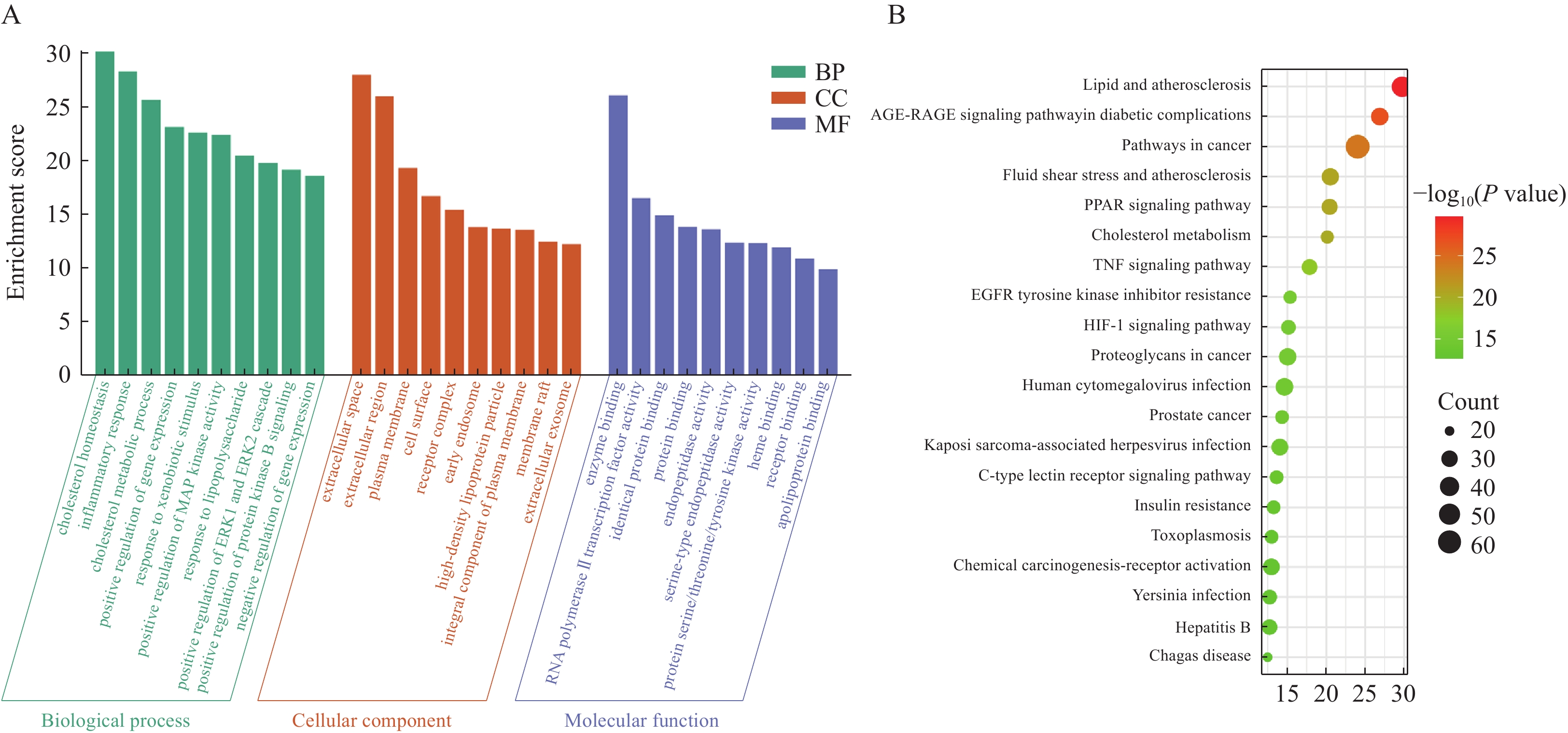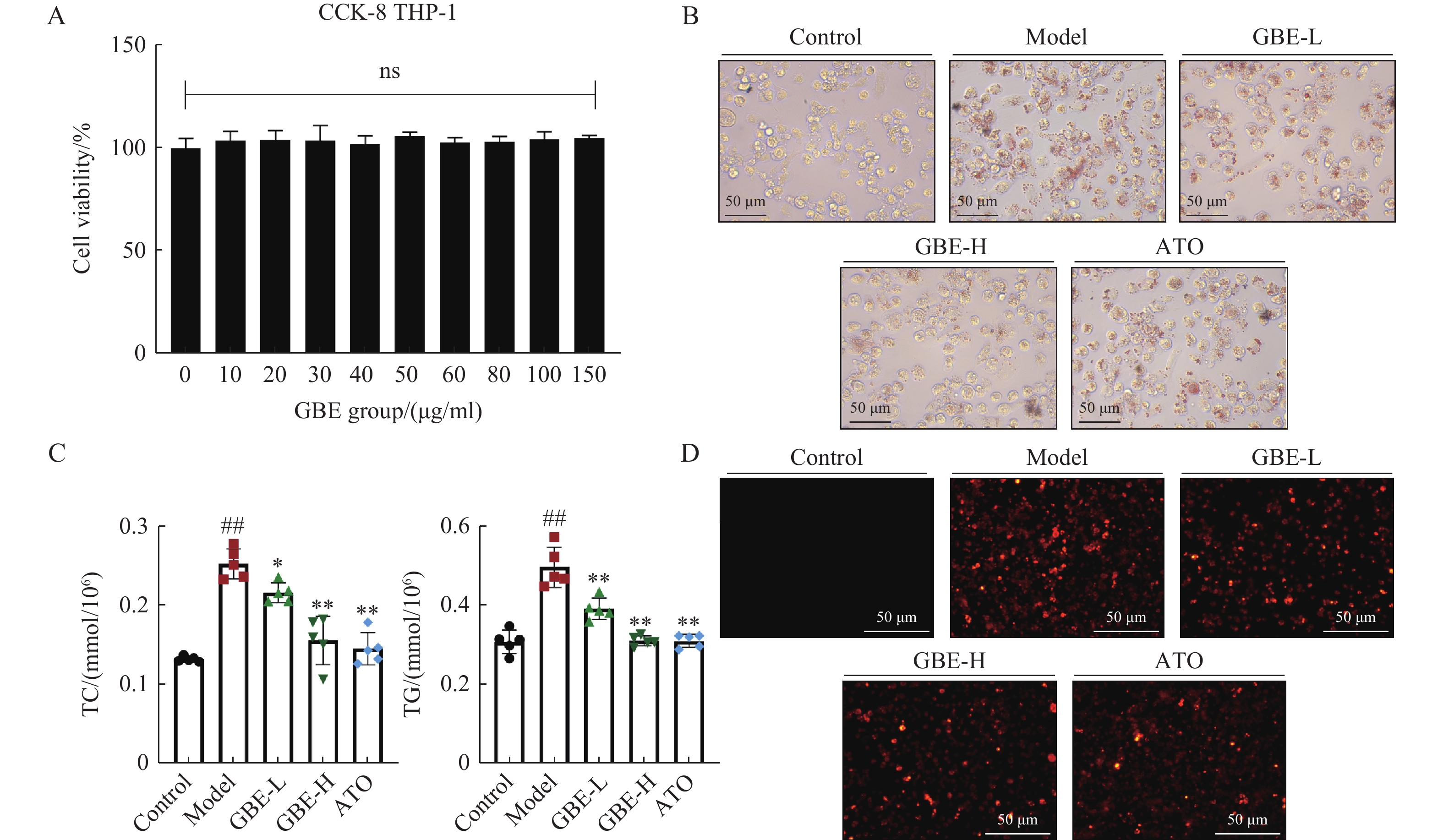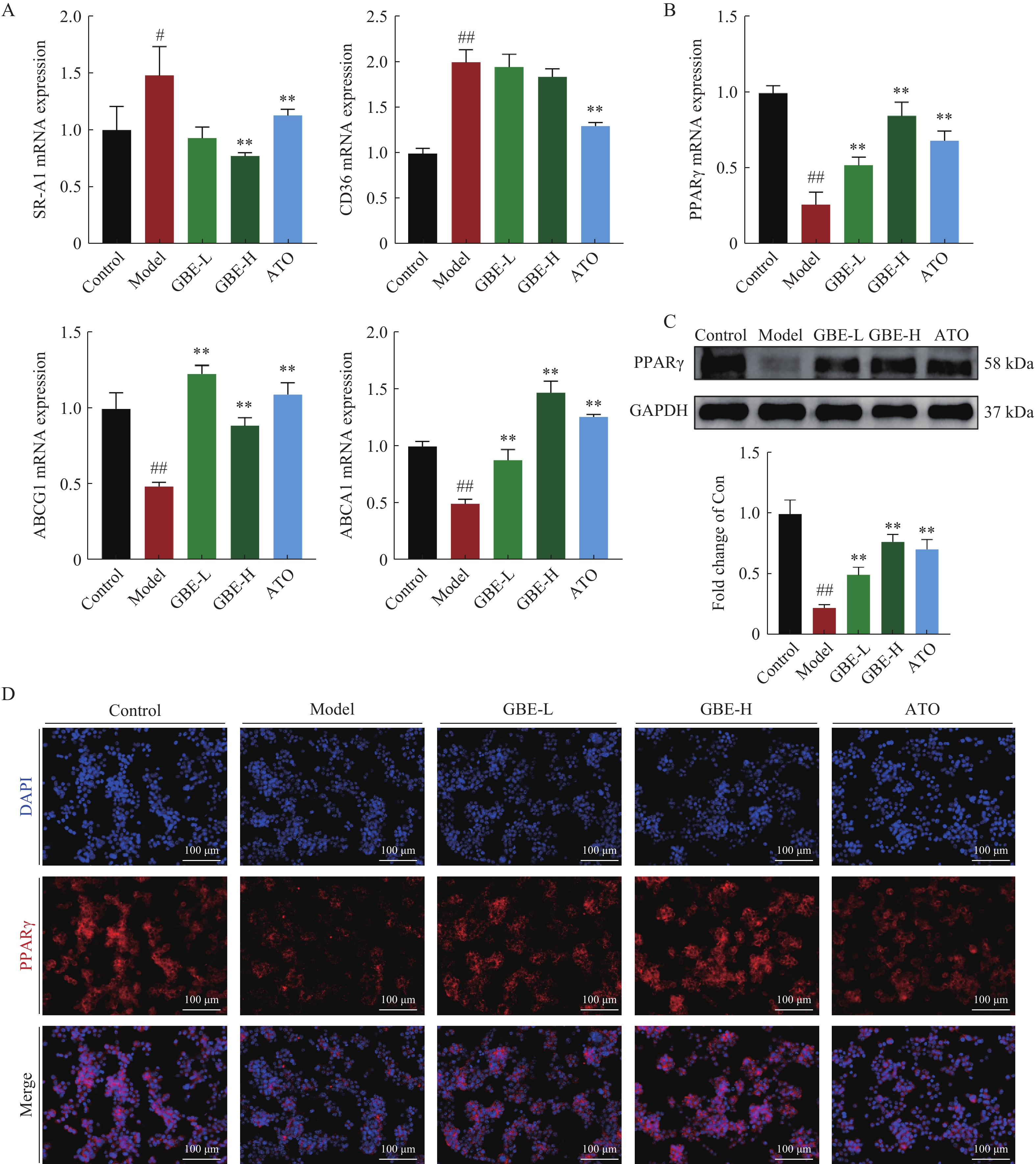Network pharmacology-based study of the mechanism of Ginkgo biloba extract (GBE) in the treatment of atherosclerosis by activating PPARγ
-
摘要:
探讨银杏叶提取物(Ginkgo biloba extract,GBE)对高脂饮食诱导的ApoE-/-小鼠动脉粥样硬化疾病(atherosclerosis,AS)的影响和作用机制。ApoE-/-小鼠灌胃给予低、高剂量GBE [50、150 mg/(kg·d)],9周后检测小鼠血脂水平,主动脉斑块脂质沉积情况、坏死核心面积和血管炎症水平。利用TCMSP、Swiss Target Prediction、Genecards等公共数据库预测GBE治疗AS的潜在靶点,通过GO和KEGG富集分析寻找其药效发挥的可能机制。在细胞水平上,氧化低密度脂蛋白(oxidized low density lipoprotein, oxLDL)处理THP-1形成泡沫细胞进行实验,使用油红O染色检测脂质蓄积情况,Dil-oxLDL检测泡沫细胞生成,使用RT-qPCR检测胆固醇摄取和外排受体的mRNA变化情况。最后,使用Western blot、免疫荧光等检测GBE对核心靶点过氧化物酶体增殖物激活受体γ (peroxisome proliferators-activated receptors-γ,PPARγ)表达情况的影响。结果显示,GBE可以减少小鼠主动脉脂质沉积和坏死核心面积,降低血清脂质和炎症水平。在体外减少巨噬细胞胆固醇摄取、增加胆固醇外排。本研究表明,GBE可以通过增强PPARγ的表达减少泡沫细胞的生成,抑制主动脉胆固醇蓄积和斑块的形成,缓解AS。
Abstract:To investigate the effect of Ginkgo biloba extract (GBE) on lipids accumulation and the progression of atherosclerosis(AS), ApoE-/- mice fed with HFD were injected i.g. with two different doses of GBE (GBE-L 50 mg/(kg·d) or GBE-H 150 mg/(kg·d)) for 9 weeks. The core targets and potential mechanisms of GBE therapy for AS were investigated using network pharmacological target prediction. Subsequently, oxidized low-density lipoprotein (ox-LDL)-induced THP-1 was used to investigate the effect of GBE on foam cell formation through oil red staining and Dil-oxLDL fluorescent staining. The mRNA alterations in cholesterol uptake and efflux receptors were detected by real-time quantitative PCR. Finally, the impact of GBE on the expression of PPARγ as the core target was assessed through Western blot and immunofluorescence. It was found that GBE improved serum lipid profile, reduced necrotic cores and lipid deposition in aortic root plaques, and decreased the level of inflammatory factors in serum of ApoE-/- mice. Moreover, GBE treatment reduced the level of intracellular lipid accumulation and inhibited cholesterol uptake and efflux to alleviate foam cell formation. GBE activated PPARγ to enhance ABCA1/ABCG1-induced cholesterol efflux in THP-1. These results suggest that GBE can suppress lipid accumulation and alleviate foam cell formation by activating PPARγ pathway.
-
Keywords:
- Ginkgo biloba extract /
- atherosclerosis /
- foam cell /
- PPARγ
-
-
Figure 1. Ginkgo biloba extract (GBE) attenuates atherosclerosis in ApoE-/- mice
A: Gross oil red O staining of aortas from C57BL/6J or ApoE-/- mice fed with WD or HFD for 9 weeks; B: Serum total cholesterol(TC), total triglycerides(TG), low-density lipoprotein cholesterol(LDL-C) and high-density lipoprotein cholesterol(HDL-C) level ($ \bar{x} \pm s $, n = 5); C: Representative images of oil red O, H&E, Masson staining of aortic root sections ($ \bar{x} \pm s $, n = 3).ATO: Atorvastatin #P <0.05, ##P<0.01 vs control group; *P <0.05, **P<0.01 vs model group
Figure 5. GBE attenuates lipid accumulation and the formation of foam cells in THP-1
A: Viability of THP-1 after treating with different concentrations of GBE was detected by the CCK-8 assay; B: THP-1 cells were stained with oil red O after exposing with oxLDL after treating by GBE (20 and 60 μg/mL) or ATO (1 μmol/L) for 24 h ($ \bar{x} \pm s $,n = 3); C: Comparison of THP-1 cells TC and TG ($ \bar{x} \pm s $,n = 5); D: Fluorescent images for macrophage lipid uptake in THP-1. THP-1 was stained with Dil-oxLDL (30 μg/mL) after treating by GBE (20 and 60 μg/mL) or ATO (1 μmol/L) for 6 h, respectively ($ \bar{x} \pm s $, n = 3) #P <0.05, ##P<0.01 vs control group; *P <0.05, **P<0.01 vs model group
Figure 6. GBE improves cholesterol uptake and efflux in foam cells by enhancing PPARγ expression ($ \bar{x} \pm s $, n = 3)
A: Relative mRNA expression of macrophage cholesterol uptake (CD36, SRA1) and efflux (ABCA1, ABCG1) in THP-1; B-C: Relative mRNA and protein expression of PPARγ in THP-1; D: Relative protein expression of PPARγ by immunofluorescent in THP-1SR-A1: Macrophage scavenger receptor class A1;CD36: Cluster of differentiation 36;ABCA1: ATP-binding cassette transporter A1;ABCG1: ATP binding cassette subfamily G member 1;PPARγ: Peroxisome proliferator activated receptor gamma#P <0.05, ##P<0.01 vs control group; *P <0.05, **P<0.01 vs model group
Table 1 Primer sequences used for quantitative real-time PCR
Gene Species Forward Reverse SR-A1 Human AAAGAAGAACAAGCGCACGTGG GAGCACCAGGTGGACCAGTTTG CD36 Human TCCTATTGGCCAAGCTATTGCG CACGGGGATTCCTTTAAGGTCG ABCA1 Human CGTTTCCGGGAAGTGTCCTA GCTAGAGATGACAAGGAGGATGGA ABCG1 Human GGGAAGTTGATAAAGGATGT GATTCGGGCTATGTATGG GAPDH Human GGAGCGAGATCCCTCCAAAAT GGCTGTTGTCATACTTCTCATGG PPARγ Human GGAAGACCACTCGCATTCCTT GTAATCAGCAACCATTGGGTCA -
[1] Libby P. The changing landscape of atherosclerosis[J]. Nature, 2021, 592(7855): 524-533. doi: 10.1038/s41586-021-03392-8
[2] Libby P, Buring JE, Badimon L, et al. Atherosclerosis[J]. Nat Rev Dis Primers, 2019, 5(1): 56. doi: 10.1038/s41572-019-0106-z
[3] Fan JL, Watanabe T. Atherosclerosis: known and unknown[J]. Pathol Int, 2022, 72(3): 151-160. doi: 10.1111/pin.13202
[4] Ouimet M, Barrett TJ, Fisher EA. HDL and reverse cholesterol transport[J]. Circ Res, 2019, 124(10): 1505-1518. doi: 10.1161/CIRCRESAHA.119.312617
[5] Liu XF, Wu JS, Tian RM, et al. Targeting foam cell formation and macrophage polarization in atherosclerosis: the therapeutic potential of rhubarb[J]. Biomed Pharmacother, 2020, 129: 110433. doi: 10.1016/j.biopha.2020.110433
[6] Wang DD, Yang Y, Lei YN, et al. Targeting foam cell formation in atherosclerosis: therapeutic potential of natural products[J]. Pharmacol Rev, 2019, 71(4): 596-670. doi: 10.1124/pr.118.017178
[7] Yvan-Charvet L, Matsuura F, Wang N, et al. Inhibition of cholesteryl ester transfer protein by torcetrapib modestly increases macrophage cholesterol efflux to HDL[J]. Arterioscler Thromb Vasc Biol, 2007, 27(5): 1132-1138. doi: 10.1161/ATVBAHA.106.138347
[8] Adorni MP, Zimetti F, Billheimer JT, et al. The roles of different pathways in the release of cholesterol from macrophages[J]. J Lipid Res, 2007, 48(11): 2453-2462. doi: 10.1194/jlr.M700274-JLR200
[9] Chiu YL, Tsai WC, Wu CH, et al. Ginkgo biloba induces thrombomodulin expression and tissue-type plasminogen activator secretion via the activation of Krüppel-like factor 2 within endothelial cells[J]. Am J Chin Med, 2020, 48(2): 357-372.
[10] Wang Y, Xu YY, Xu XW, et al. Ginkgo biloba extract ameliorates atherosclerosis via rebalancing gut flora and microbial metabolism[J]. Phytother Res, 2022, 36 (6): 2463-2480.
[11] Liu HJ, Wang XL, Zhang L, et al. Inhibitions of vascular endothelial growth factor expression and foam cell formation by EGb 761, a special extract of Ginkgo biloba, in oxidatively modified low-density lipoprotein-induced human THP-1 monocytes cells[J]. Phytomedicine, 2009, 16(2/3): 138-145.
[12] Li TH. Ginkgo biloba extract (EGb761) inhibiting smoothmuscle foam cell formation and the underlying mechanisms (银杏叶提取物EGb761抑制平滑肌细胞泡沫化的机制研究)[D]. Xi’an: Air Force Medical University, 2019. [13] Tall AR, Thomas DG, Gonzalez-Cabodevilla AG, et al. Addressing dyslipidemic risk beyond LDL-cholesterol[J]. J Clin Invest, 2022, 132(1): e148559. doi: 10.1172/JCI148559
[14] Bäck M, Yurdagul A Jr, Tabas I, et al. Inflammation and its resolution in atherosclerosis: mediators and therapeutic opportunities[J]. Nat Rev Cardiol, 2019, 16(7): 389-406.
[15] Miao M, Wang X, Liu T, et al. Targeting PPARs for therapy of atherosclerosis: a review[J]. Int J Biol Macromol, 2023, 242 (Pt 2): 125008.
[16] Singh S, Changkija S, Mudgal R, et al. Bioactive components to inhibit foam cell formation in atherosclerosis[J]. Mol Biol Rep, 2022, 49(3): 2487-2501. doi: 10.1007/s11033-021-07039-9
[17] Ference BA, Graham I, Tokgozoglu L, et al. Impact of lipids on cardiovascular health: JACC health promotion series[J]. J Am Coll Cardiol, 2018, 72(10): 1141-1156. doi: 10.1016/j.jacc.2018.06.046
[18] Ference BA, Ginsberg HN, Graham I, et al. Low-density lipoproteins cause atherosclerotic cardiovascular disease. 1. Evidence from genetic, epidemiologic, and clinical studies. A consensus statement from the European Atherosclerosis Society Consensus Panel[J]. Eur Heart J, 2017, 38(32): 2459-2472. doi: 10.1093/eurheartj/ehx144
[19] Raja V, Aguiar C, Alsayed N, et al. Non-HDL-cholesterol in dyslipidemia: review of the state-of-the-art literature and outlook[J]. Atherosclerosis, 2023, 383: 117312. doi: 10.1016/j.atherosclerosis.2023.117312
[20] Tang HY, Xing CH, Zhang MM. Research progress on role of ABCA1 in regulation of cell death in atherosclerosis[J]. Lab Med Clin (检验医学与临床), 2023, 20(13): 1945-1949. [21] Westerterp M, Bochem AE, Yvan-Charvet L, et al. ATP-binding cassette transporters, atherosclerosis, and inflammation[J]. Circ Res, 2014, 114(1): 157-170. doi: 10.1161/CIRCRESAHA.114.300738
[22] Xu PF, Zhai YG, Wang J. The role of PPAR and its cross-talk with CAR and LXR in obesity and atherosclerosis[J]. Int J Mol Sci, 2018, 19(4): 1260. doi: 10.3390/ijms19041260
[23] Doran AC. Inflammation resolution: implications for atherosclerosis[J]. Circ Res, 2022, 130(1): 130-148. doi: 10.1161/CIRCRESAHA.121.319822
[24] Pradhan AD, Aday AW, Rose LM, et al. Residual inflammatory risk on treatment with PCSK9 inhibition and statin therapy[J]. Circulation, 2018, 138(2): 141-149. doi: 10.1161/CIRCULATIONAHA.118.034645
[25] Everett BM, MacFadyen JG, Thuren T, et al. Inhibition of interleukin-1β and reduction in atherothrombotic cardiovascular events in the CANTOS trial[J]. J Am Coll Cardiol, 2020, 76(14): 1660-1670. doi: 10.1016/j.jacc.2020.08.011
[26] Tardif JC, Kouz S, Waters DD, et al. Efficacy and safety of low-dose colchicine after myocardial infarction[J]. N Engl J Med, 2019, 381(26): 2497-2505. doi: 10.1056/NEJMoa1912388
[27] Nidorf SM, Fiolet ATL, Mosterd A, et al. Colchicine in patients with chronic coronary disease[J]. N Engl J Med, 2020, 383(19): 1838-1847. doi: 10.1056/NEJMoa2021372
[28] Ibañez B, Fuster V. CANTOS: a gigantic proof-of-concept trial[J]. Circ Res, 2017, 121(12): 1320-1322. doi: 10.1161/CIRCRESAHA.117.312200
[29] Schenone AL, Menon V. Colchicine in pericardial disease: from the underlying biology and clinical benefits to the drug-drug interactions in cardiovascular medicine[J]. Curr Cardiol Rep, 2018, 20(8): 62. doi: 10.1007/s11886-018-1008-5
[30] Singh SK, Srivastav S, Castellani RJ, et al. Neuroprotective and antioxidant effect of Ginkgo biloba extract against AD and other neurological disorders[J]. Neurotherapeutics, 2019, 16(3): 666-674. doi: 10.1007/s13311-019-00767-8
[31] Sun J. A comprehensive study on the effects of Ginkgo biloba extract on the mechanism of atherosclerosis(银杏叶提取物对动脉粥样硬化相关机制影响的综合研究)[D]. Dalian: Dalian Medical University, 2015. [32] Ou HC, Hsieh YL, Yang NC, et al. Ginkgo biloba extract attenuates oxLDL-induced endothelial dysfunction via an AMPK-dependent mechanism[J]. J Appl Physiol (1985), 2013, 114 (2): 274-285.
[33] Jiao YB, Rui YC, Li TJ, et al. Expression of pro-inflammatory and anti-inflammatory cytokines in brain of atherosclerotic rats and effects of Ginkgo biloba extract[J]. Acta Pharmacol Sin, 2005, 26(7): 835-839. doi: 10.1111/j.1745-7254.2005.00106.x



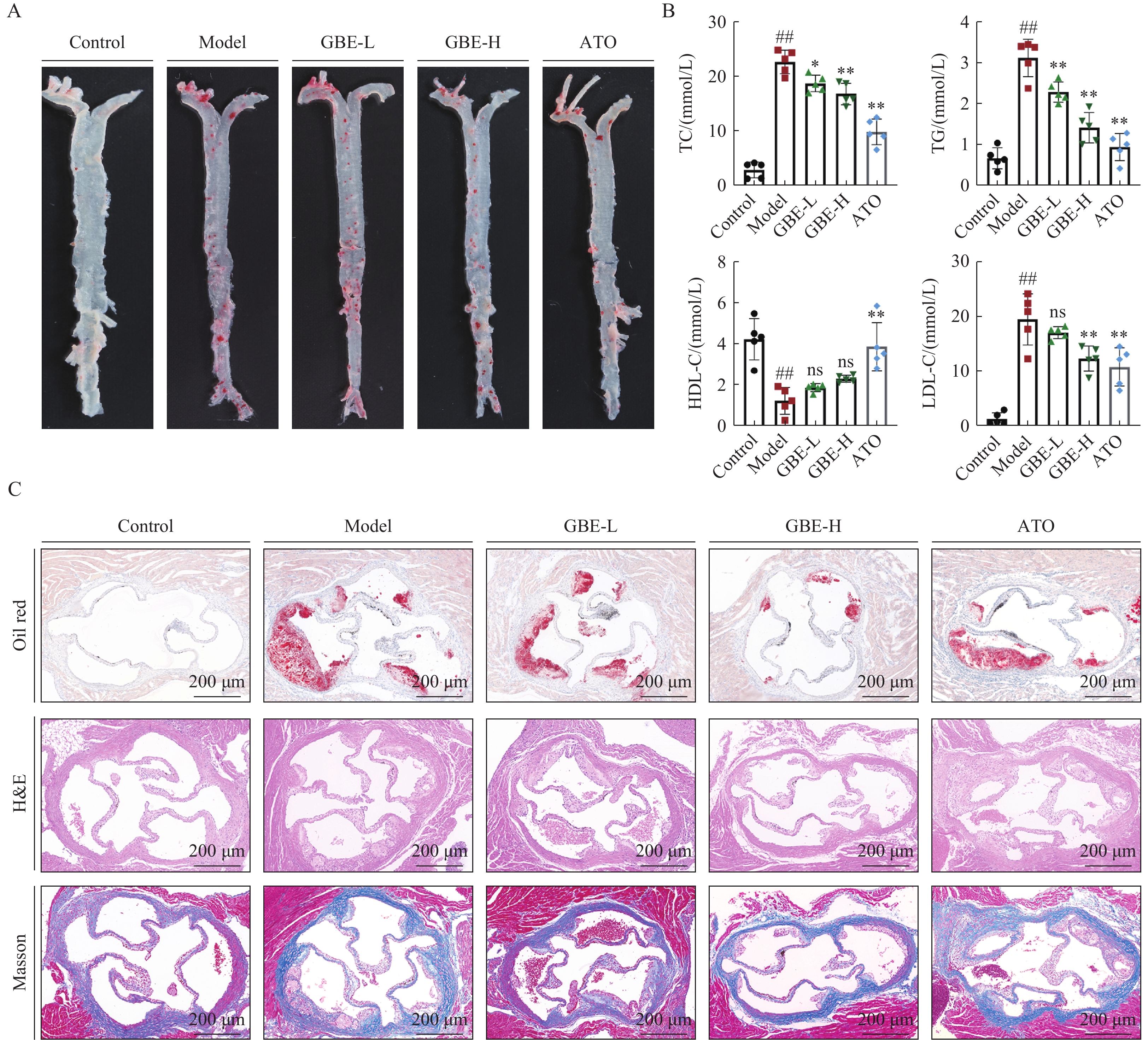
 下载:
下载:

